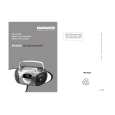|
|
|
Kategorie
|
|
Informacje
|
|
Polecamy
|
|
|
 |
|
|
Dla tego produktu nie napisano jeszcze recenzji!
 ;
jedyne do czego mogę mieć zastrzeżenie to jakość zdjęć zawartych w przesłanej instrukcji serwisowej ponieważ są fatalnej jakości, praktycznie nieczytelne. tak poza tym jestem zadowolony to jest to czego szukałem.
 ;
Wszystko w porządku.
Instrukcja czytelna i kompletna.
Dziękuję.
all right!
thank you.
 ;
Bardzo dobra instrukcja. Zawiera wszystko co potrzeba, polecam!
 ;
Instrukcja jest OK. Schematy czytelne, opisane niektóre procedury.
 ;
Instrukcja bardzo czytelna. zawiera co potrzeba. Polecam
UX-M5
Cassette amplifier section
Item Head azimuth adjustment Measuring condition Test tape: Check and adjustment procedure 1.Play back the test tape VT702 (8kHz). Standard value Output level: Within 2dB of maximum output Phase difference R and L channels: Minimum Adjusting part Head azimuth adjusting screw (To be used only after head replacement) See Fig.1 on page 1-16. VT702 (8kHz) 2.Adjust the head azimuth adjusting screw so that the Signal output terminal: phase difference between the R and L channels is H.phone out (with 32 ohm load) minimized at an output level that is within maximum output level. After this adjustment, lock the head azimuth adjusting screw with screw sealant to cover more than a half of the screw head. 3.When the head azimuth is maladjusted, correct it with the head azimuth adjusting screw. Tape speed and wow/flutter check and adjustment Test tape: 1.Play back the test tape VT712 (3kHz) by the end VT712 (3kHz) portion. Signal output terminal: 2.Connect a frequency counter and check that it reads 2940 to 3090Hz H.phone out between 2940 and 3090Hz. If not, adjust the frequency (with 32 ohm load) with the motor semifixed resistor. 3.Check that the wow/flutter is within 0.38% (unweighted). PB frequency response check Test tape: VT702 Signal output terminal: H.phone out (with 32 ohm load) Tape: Normal Signal output terminal: Cassette REC./PLAY HEAD Test tape: AC225 Signal input: SG 1kHz -20dBs with emphasis Signal output terminal: H.phone out (with 32 ohm load) Play back the test tape VT702 while con-firming that deviation between the 1kHz signal and 8kHz signal should be (0+3dB-6dB). Within 0.38% (unweighted) Deviation between 1kHz and 8kHz: (0+3dB-6dB) L203, P201 See Fig.3 on page 1-16. Tape speed: Motor semifixed resistor
2dB of the level
See Fig.2 on page 1-16. Check only
Bias frequency check
REC and PB frequency response adjustment
Set the TUNER or CD function and with TAPE to record. Check to see if the frequency at the measuring point P201 is 67kHz 1kHz if not adjust L203 until the frequency counter indicates 67 kHz 1kHz. At TUNER, set the BAND to the FM position, and Level difference for record the reference 1kHz signal and 8kHz signal 1kHz singnal: Within alternately repeatedly. While playing back the recorded (0+3dB-6dB) signal of the 1kHz signal differ from that of the 8kHz signal by within (0+3dB-6dB).
Tuner section
Item AM IF adjustment Measuring condition Signal input: Loop antenna Signal output: IC101 pin19 Check and adjustment procedure 1.Set the intermediate frequency sweep generator to AM 450kHz. 2.Adjust T101 for maximum and center output. Standard value Adjusting part
T101 See Fig.3 on page 1-16. L101, P107
AM tracking adjustment
Signal input: Loop antenna Signal output: H.phone out (with 32 ohm load)
1.Set the TUNER at 522kHz adjust L101 until the test point P107 voltage at 1.1V 0.1V. 2.Set the TUNER at 1629kHz, check the test point P107 voltage at 7.0V 0.3V. 3.Set the TUNER and S/G at 603kHz, adjust L102 for maximum output. 4.Set the TUNER and S/G at 1404kHz, adjust the TC101 for maximum output. 5.Repeat the above steps 3 and 4. 1.Set the TUNER at 87.5MHz adjust the L104 until the test point P105 voltage at 2.3V 0.1V. 2.Set the TUNER at 108MHz, check the test point P105 voltage at 6.5V 0.3V. 3.Set the TUNER and S/G at 90.1MHz, adjust L103 for maximum output. 4.Set the TUNER and S/G at 106.1MHz, adjust the TC102 for maximum output. 5.Repeat the above steps 3 and 4.
L102 TC101 See Fig.3 on page 1-16. L104, P105
FM tracking adjustment
Signal input: Dummy antenna FM ANT FM GND Signal output: H.phone out (with 32 ohm load)
L103 TC102 See Fig.3 on page 1-16.
1-15
|
|
 |
> |
|

